Development and Verification of Activated Source Term Library Based on ENDF/B-VIII.0
Abstract
Developed by the Oak Ridge National Laboratory (ORNL) in the United States, the ORIGEN code for computing irradiation and decay processes is one of the most widely used point depletion programs. However, the nuclear data that accompanies it, crucial for its application, has been measured and evaluated a long time ago. This results in noticeable deficiencies when addressing the analysis needs of shielding source terms for advanced reactors. To effectively enhance the precision of source term calculations and achieve autonomous control over the activated source term library, this study has developed the PyTape program based on a newer version of the authoritative evaluated nuclear library to assist in automating the library processing. On this foundation, the study makes reasonable predictions of the impact arising from the inconsistent distribution of microscopic data. It conducts comparative verification of the library’s computational capabilities through benchmark model analysis and assesses the effects of data iteration in the irradiation and decay calculations of typical activation materials. The research results indicate that updating the evaluated nuclear data version has a significant effect on improving the accuracy of activated source term calculations based on the ORIGEN program. Therefore, the library iteration pathway established in this study can be effectively applied in precise calculations of activated source terms in practical engineering projects.
1. Introduction
During the operation of a reactor, a large number of neutrons are generated, causing irradiation damage to the reactor components containing easily activatable nuclides, thereby posing challenges for radiation shielding and decommissioning of nuclear facilities. Activation reactions are prevalent in various types of reactor systems, such as the operational issues faced in traditional large commercial pressurized water reactors (PWRs), which often involve the radiation dose assessment of activation corrosion sources [1]. Advanced reactors face more complex activation issues in shielding and radiation protection, including shell corrosion and coolant flushing in a single loop of high-flux water-cooled reactors [2], coolant radiation capture sources like Na-24 in sodium-cooled fast reactors [3], and gamma photon penetration in solid-state reactors [4]. Research on irradiation and activation issues undoubtedly holds significant importance, as nuclear libraries, the foundation for reactor physics calculations, lay the groundwork for high-precision burnup and source term analyses.
ORIGEN2, developed by Oak Ridge National Laboratory (ORNL), is a typical single-group point burnup and decay irradiation calculation code [5]. Due to its straightforward installation and operation, high computational efficiency, and externally decodable numerical working library units that are easy to update and replace, ORIGEN2 has been widely used in calculations and research in the field of reactor burnup and activation source term analysis. However, it is worth noting that in the Tape9 nuclear library file accompanying the ORIGEN2 code, decay data for 427 long-lived nuclides come from ORNL’s Evaluated Nuclear Structure Data File (ENSDF) [6], while data for ~600 remaining radioactive isotopes are sourced from the ENDF/B-IV nuclear evaluation library [7]. Both of these data files were released about 50 years ago. With the rapid development of advanced reactors and the increasing demands for design and calculations, nuclear data determination and evaluation have been iteratively evolving. For instance, the National Nuclear Data Center (NNDC) released evaluation library files ENDFB-Ⅶ.0 [8], ENDFB-Ⅶ.1 [9], and ENDFB-Ⅷ.0 [10] in 2006, 2011, and 2018, respectively. In 2017, the European Atomic Energy Community (NEA) released the latest version of the JEFF-3.3 [11] library, significantly improving the measurement levels of neutron data, including light nuclei, structural materials, thermal neutron scattering cross-sections, gamma-ray spectra, etc., incorporating a wide range of neutron data standards from IAEA-funded projects, CIELO experimental programs, and other measurements. Clearly, as evaluation data versions change, outdated nuclear data sources cannot meet the requirements for high-fidelity, large-scale burnup calculations and detailed activation calculations.
Therefore, based on the latest version of the evaluation nuclear library, this paper develops a Python program to assist in creating an activation source term library in CCC-371 format applicable to ORIGEN2 using the RSICC calculation code NJOY. The computational capability of the activation source term library is validated through burning benchmark problems, and the improvement in the accuracy of source term calculations due to the iteration of nuclear data sources is demonstrated through the analysis of inconsistencies between microscopic data and typical activation cases. The developed library creation scheme in this study can provide an effective reference for the production of source term libraries and shielding calculations in practical engineering.
2. Processing Methodology of the Activated Source Term Library
2.1. Processing Workflow
The generation of a single-group equivalent cross-section library for the burnup code ORIGEN2 requires a series of processing steps and treatments applied to the evaluated nuclear library. The neutron reaction sublibrary required for the burnup program is obtained by reading, converting, calculating, and organizing the evaluated library using the mainstream nuclear data processing software NJOY. The primary function of the MODER module is the binary conversion of nuclear data, aiming to enhance the processing efficiency of numerical nuclear data files. The source file is transformed into a binary file within the module for internal operations, and it is reverted after processing, facilitating external program and code accessibility.
The overall processing workflow of the Tape9 library is illustrated in Figure 1.
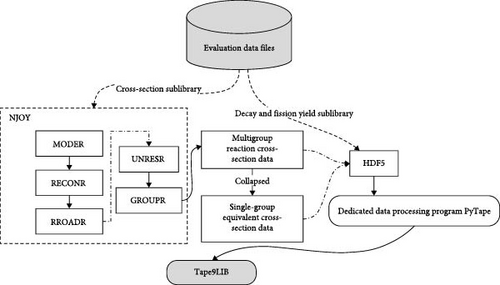
The evaluated library provides cross-section information for multiple primary neutron reactions for each isotope. After consolidation, the corresponding multigroup cross-sections, single-group equivalent cross-sections, and their metadata are written into the respective groups in the library. The library includes cross-section data for six major neutron reactions, and two excited state reactions considered crucial in burnup and source term calculations. When the program reads the actinide (A) cards, there are six neutron reactions with the equivalent cross-section data for the (n, γ), (n, 2n), (n, 3n), (n, f), (n, γ) ∗, and (n, 2n) ∗ reactions to be considered. In contrast, when the program processes the activation and fission product (FP) fields, the third and fourth parameters are replaced with the equivalent cross-section values for the (n, α) and (n, p) reactions, respectively. The cross-section data for the other neutron reactions remain in the same positions across all types of information cards as they do in the A cards.
In addition to the reaction cross-section data, a comprehensive activated source term library also includes radioactive decay data and fission yield data. Since the ORIGEN code can automatically compress the burnup chain based on yields and half-lives, the burnup sublibrary of the evaluated library directly provides these two sets of data and their metadata, which are processed into the respective nuclide groups.
The PyTape program initially reads the decay data of nuclides contained in the incident neutron sublibrary, organizing it into radioactive decay data sequences in the corresponding format. It then reads in the six reaction cross-section data for isotopes in the same arrangement. At the end of each cross-section card, an identifier controls whether the yield card is read, with the input yield data sharing a data sequence with the corresponding cross-section data.
The current ORIGEN2 program uses the radioactive decay and fission yield library Tape9-B4. However, since this paper aims to study the importance of library iteration based on evaluated data versions for precise burnup and activated source term calculations, the latest authoritative evaluated nuclear library file ENDFB-VIII.0 is selected for processing the Tape9-B80 library. Libraries from other sources can be processed using the same workflow, and the resulting Tape9-B71, Tape9-B70, and Tape9-J33 libraries are verified accordingly.
2.2. Decay and Fission Yield Library Content Design
The radioactive decay library mainly contains information about isotopic decay constants, available energy from decay reactions, natural enrichment in the environment, and products and branching ratios of various decay modes. The decay constants are always recorded in terms of half-life, in seconds (s), and the unit for available energy is megaelectron volts (MeV). It is important to note that, due to the RSIC code’s special handling of extremely short-lived nuclides, marking values below 10−7 s in the library may cause program faults, and a placeholder of “1.000E-03” is uniformly used. The Tape9-B80 library primarily considers seven decay modes supported by ENDF, as shown in Table 1. Additionally, three physical quantities are further considered in the RSIC computational program’s decay sublibrary:
| RTYP | Decay mode | Command1 | |
|---|---|---|---|
| 0 | γ-Rays | Unassigned | |
| 1 | β-Rays | FBX (excited-state nuclei only) | |
| 2 | Electron capture and/or positron emission | FPEC, FPECX (excited-state nuclei only) | |
| 3 | Isometric transition | FIT | |
| 4 | α Decay | FA | |
| 5 | Neutron emission | Unassigned | |
| 6 | Spontaneous fission | FSF | |
| 7 | Proton emission | Unassigned | |
| 10 | Unknown origin | Unassigned | |
| Multimode combination | R1.R2…… | Mode R1 + Mode R2 + …… | |
| 1.5 | Beta and neutron | FN (emission of electrons only) | |
| Others | Others | Unassigned | |
- 1.
The natural abundance of isotopes (calculated as atomic percent).
- 2.
Information on the radioactivity concentration of nuclides continuously inhaled in unrestricted areas.
- 3.
Information on the radioactivity concentration of nuclides continuously ingested in unrestricted areas.
These three pieces of data come from nuclear data sheets published by the IAEA or some federal regulations publicly available from ORNL and are used only in some special calculations, thus having a lower frequency of usage.
Fission yield data, fundamental to burnup calculations, are usually presented as the measured values of fissionable nuclides at multiple energy points. In the nuclear evaluation library ENDFB-VIII.0, yield data are available for 31 isotopes at four fission energy points: 0.0253 eV, 500 keV, 2 MeV, and 14 MeV. However, not all FPs have yields measured at all four energy points. Most isotopes provide data for two or three energy points, and the 31 isotopes include a total of 41 fission energy points and 11 fusion energy points. Notably, Pu-239 is the only isotope for which fission yield data are provided specifically at 2 MeV. The total number of FPs (counting ground state and excited state nuclei separately) is required not to exceed 2500, with typical counts between 1200 and 1300. Given the large memory requirements for storing burnup chain information, the evaluation process often necessitates selective inclusion of fission yield data. The Tape9-B4 library retains partial fission yield values for Th, U, Pu, Cm, and Cf isotopes. To enhance calculation accuracy without significantly increasing memory usage, the Tape9-B80 library expands the fission yield sublibrary to include 850 FPs, originating from 12 fission reactions of 8 fissile isotopes, recorded as percentages, as shown in Table 2. The yield data in Tape9-B4 mostly originate from binary fission and also provide tertiary fission yields for some important low-mass nuclei. The yield data in Tape9-B80 do not consider yields producing light nuclei, and the total yield for a single fissile isotope is 200% (unit: %), meaning that tertiary fission yields are not included.
| Card number | Fission species | Energy points |
|---|---|---|
| 1 | Th-232 | 500 keV, 14 MeV |
| 2 | U-233 | 0.0253 eV, 500 keV, 14 MeV |
| 3 | U-235 | 0.0253 eV, 500 keV, 14 MeV |
| 4 | U-238 | 500 keV, 14 MeV |
| 5 | Pu-239 | 0.0253 eV, 500 keV, 2 MeV, 14 MeV |
| 6 | Pu-241 | 0.0253 eV, 500 keV |
| 7 | Cm-245 | 0.0253 eV |
| 8 | Cf-249 | 0.0253 eV |
2.3. Data Sources and Storage Structure
The PyTape program processes two main types of data: reaction cross-section data, which are consolidated from multigroup cross-sections generated by the GROUPR module, and radioactive decay and fission yield data, which are extracted from the evaluation library by the program itself. Due to the difficulty in preserving complete data information in a numerical library in text format and its poor extensibility, and because binary libraries, though fast in read/write operations, make the data values inaccessible for user viewing and are only suitable for use in intermediate program transfers, the HDF5 hierarchical data format [13] is adopted for storing all the aforementioned data sources. In the Tape9-B80.h5 root group file, groups (named after nuclides) are created to store the corresponding decay, neutron reaction information, etc., in the form of groups or datasets under the group path. Additionally, metadata such as data type, data storage space, compressibility, and custom properties are stored with the corresponding group or dataset. The same method is used to create corresponding Tape9-B71.h5, Tape9-B70.h5, and Tape9-J33.h5 files. This approach facilitates the use of the PyTape program’s submodules for CCC-371 format library read/write operations while preserving the integrity of nuclear data information for easy reference and use in the production of other types of libraries and related data research.
The PyTape program extracts a total of 3818 isotopic nuclear data information entries from the HDF5 based on ENDFB-VIII.0, including all decay data, fission yield information, and neutron reaction cross-section information recognizable by the ORIGEN2 code, along with their consolidated values. Data fields are written according to isotope categories, with nuclides in each field arranged in ascending order based on their six-digit identification numbers. Ultimately, the activation product (AP), A, and FP fields contain 1376, 258, and 1758 isotopic data fields or information cards, respectively. Of these, there are 1290 information cards for unstable nuclides, and 1696 isotopic data fields contain decay sublibrary information.
3. Microscopic Numerical Difference Analysis
In practical irradiation and decay calculations, the ORIGEN code uses single-group cross-sections, multiplied by the calculated or externally input flux, to obtain the correct reaction rates. Single-group cross-sections are highly specific physical quantities that depend on reactor and fuel types and must be determined based on the specific system being analyzed (including fuel type and enrichment, burnup, temperature, moderator-to-fuel ratio, control drum arrangement, etc.). Due to the limitations of the numerical calculation methods in point burnup programs, more accurate burnup calculations typically require external, complex reactor physics codes. In other words, neutron reaction cross-section equivalent data in burnup and activation calculations are actually variables dependent on the real-time conditions of the reactor. Therefore, in studies focusing on activation source term calculations, the cross-section sublibrary is not directly compared.
The inconsistencies between the half-lives and decay constants of nuclides measured in evaluation files are characterized by relative deviation. In the library, decay constants of 1010 isotopes showed deviations. The distribution of these isotopes’ relative deviations according to their proton numbers is shown in Figure 2. About 51.5% of these isotopes, mostly medium-mass nuclei with atomic mass numbers between 30 and 60, have deviations less than 10%. This category includes many long-lived As and FPs, such as Th-230, Pu-244, Pu-239, and Np-239. The deviations in this group are relatively minor due to ongoing improvements in half-life measurement methods. Additionally, about 25.9% of the isotopes have decay constant deviations ranging from 10% to 100%. This group almost excludes light nuclei with atomic mass numbers below 25 or transuranic elements, suggesting that these isotopes might have had certain measurement errors in older evaluation libraries. Corrections to their half-lives can contribute to the accuracy of calculations. Finally, ~22.5% of the isotopes have deviations exceeding 100%, with the highest reaching 200%. These isotopes might have had significant systematic or estimation errors in early measurement schemes. As data evaluations have been iteratively corrected, isotopes found in common reactor irradiation structural materials, such as Fe-55, Fe-59, Sb-134, and Sb-136, fall into this category, significantly impacting the results of irradiation calculations for activation materials.
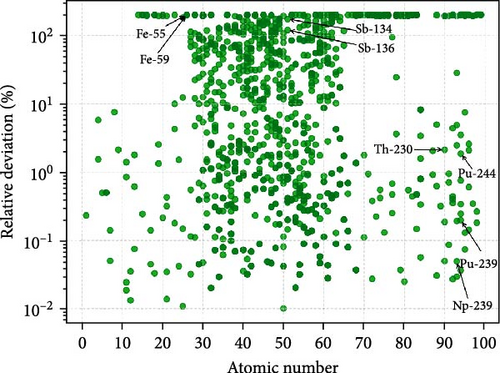
In the Tape9 nuclear library, the number of decay modes considered n is 6. Xb4i and Xb80i represent the branching ratios for corresponding decay reactions in the two versions of the nuclear library, with the types of decay reactions referenced in Table 1. The RMSD values, mapped against the relative atomic masses of the isotopes, are depicted in Figure 3. Out of 799 isotopes with non-zero RMSD values in the library, 76.7% have an RMSD within the range of 0–1, and 49.6% of isotopes have an RMSD between 0.4 and 0.6. This range is predominantly due to revisions in the branching ratios of various types of alpha or beta decays and includes key isotopes relevant to activation calculations, such as Co-58, Am-241, and Zn-65, all having an RMSD of 0.57735. Corrections within this range might impact the precision of actual computational analyses. Notably, isotopes like Ga-80, Sb-141 m, and Rb-95 exhibit significant deviations, with RMSD values exceeding 4.5, primarily caused by a surge in the branching ratios of beta-plus decays leading to excited-state daughters (FPECX). Additionally, among isotopes with an RMSD greater than 1, the majority of data deviations are due to increases in the branching ratios of complex beta decays producing neutrons (FN), implying that they are unlikely to significantly affect actual activated source term calculations.
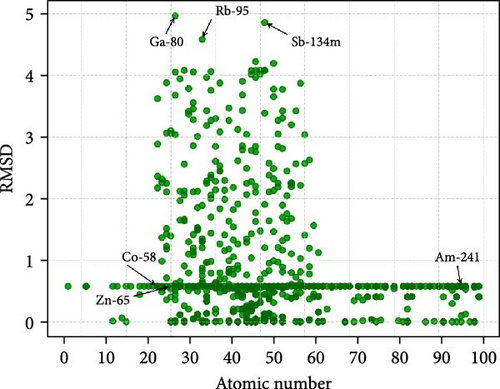
4. Irradiation and Decay Cases Verification
4.1. Validation of Burnup Benchmark for Different Reactor Types
Considering that decay and yield data are fundamental for burnup calculations to validate the accuracy of the developed library, benchmark calculations for irradiation burnup processes in four different reactor types were conducted. The results obtained from the Tape9-B80 library were then compared with the computational results provided by ORNL.
For traditional PWRs, burnup calculations utilized 3.2% enriched uranium dioxide fuel and assembly hardware. The reactor operated over three cycles, each lasting 1092 days. The core components, along with Zircaloy-4 cladding, 304 stainless steel, 302 stainless steel, INCONEL-718, and NICROBRAZE-50 nickel alloys, underwent alternating irradiation at a constant flux for 293.3 days and 106 days of decay. The irradiation flux in the stainless-steel region was set to 0.011 of the core regions, while other areas received full flux irradiation. The end-of-cycle burnup reached 33,000 MWd/mt. Neutron cross-section libraries of 204, 205, and 206 were employed for structural materials, As, and FPs, respectively(the description of the cross-section sublibrary is shown in Table 3).
| Type of library | Activation product | Actinide | Fission product |
|---|---|---|---|
|
204 | 205 | 206 |
| PWR CORE: Enriched UO2 | 251 | 252 | 253 |
|
401 | 402 | 403 |
|
311 | 312 | 313 |
|
331 | 332 | 333 |
For boiling water reactors (BWRs) operating in a four-cycle subcritical mode, the benchmark involved loading 2.75% enriched uranium dioxide fuel. The primary irradiation materials included Zircaloy-4, Zircaloy-2 alloys, 304 and 302 stainless steels, and nickel-based high-temperature deformation alloys. The core’s discharge burnup was 27,500 MWd/mt over a cycle of 1379.8 days, comprising an irradiation scheme alternating between 265.45 days of constant power irradiation and 160 days of decay. The flux in the zirconium cladding and stainless-steel regions was set to half of that in the core. The irradiation subjects were 1000 kg of impurity-containing fuel assemblies and 1 kg of each of the aforementioned ex-core irradiation materials. Structural materials, As, and FPs employed neutron cross-section libraries of 251, 252, and 253, respectively.
Table 4 presents the infinite multiplication factor (Kinf) and its computational deviation calculated by the point burnup code at the end of each cycle [15]. As can be observed, although there is a slight increase in computational deviation over the reactor’s lifespan, the absolute values of the deviations remain within 30 pcm, which is within a reasonable range. This indicates a good numerical agreement, demonstrating the library’s capability for accurate calculations in full-core irradiation decay problems.
| Cycle | Kinf (ORNL) | Kinf (Tape9-B80) | Deviation (pcm) |
|---|---|---|---|
| PWR-cycle 1 | 1.03183 | 1.03189 | 6 |
| PWR-cycle 2 | 1.02584 | 1.02580 | −4 |
| PWR-cycle 3 | 1.00923 | 1.00904 | −19 |
| PWR-cycle 4 | 0.98638 | 0.98614 | −24 |
| BWR-cycle 1 | 0.95871 | 0.95876 | 5 |
| BWR-cycle 2 | 0.95349 | 0.95346 | −3 |
| BWR-cycle 3 | 0.93900 | 0.93885 | −15 |
| BWR-cycle 4 | 0.91899 | 0.91877 | −22 |
To further validate the computational capabilities of the library in advanced reactor designs, benchmark calculations were conducted for an advanced oxide-coated liquid metal fast breeder reactor (LMFBR) and a CANDU reactor. The CANDU reactor model was a benchmark problem with one metric ton of initial heavy metal, using natural-enriched uranium fuel. A fixed-power irradiation of 25.57 MW was implemented in the burnup zone for 293.31 days, achieving a burnup of 7500 MWd/mt. Simultaneously, constant flux irradiation was conducted in the zirconium alloy cladding and lattice grid areas at the core flux level, with the total mass of structural materials being 1 kg. Neutron cross-section libraries 401, 402, and 403 were used for structural materials, As, and FPs, respectively.
The composition of the liquid metal-cooled reactor is more complex. The fuel area was loaded with one metric ton of uranium–plutonium mixed oxide (MOX) fuel, with an enrichment of ~10% in Pu-239. Mixed depleted uranium fuel was used, and uranium or thorium coatings were applied radially and axially to the baskets. The cladding material was 316 stainless steel. A fixed-power irradiation of 123.25 MW was carried out in the fuel assembly and structural material areas for a total of 821.82 days, achieving a burnup of 101.3 GWd/mt. After refueling, constant flux irradiation was performed. Neutron cross-section libraries 311, 312, and 313 were used for structural materials, As, and FPs, respectively. By storing and outputting vectors of the radioactivity intensity of activation and FPs, isotopic concentrations in the reactor, and the release rates of photons and energy during these two benchmark processes, it facilitated the tracking of the transmutation process.
After the completion of the irradiation schemes, the photon emission rates of FPs in the CANDU reactor core components and activated products in cladding materials were compared with the benchmark results provided by ORNL, as shown in Figure 4a. The benchmark comparison results for the photon and energy release rates of core FPs in the liquid metal breeder reactor are shown in Figure 4b. As can be seen from the figures, the developed library achieved good fitting results in both the CANDU reactor core and cladding irradiation calculations and the fuel coating irradiation calculations of the LMFBR. The activation calculations in the Zircaloy-4 alloy cladding and lattice framework of the CANDU reactor showed almost no deviation in each energy group. However, both types of cores showed greater deviations in the high-energy photon region of 4–8 MeV. The calculation results in other energy groups remained well-fitted.
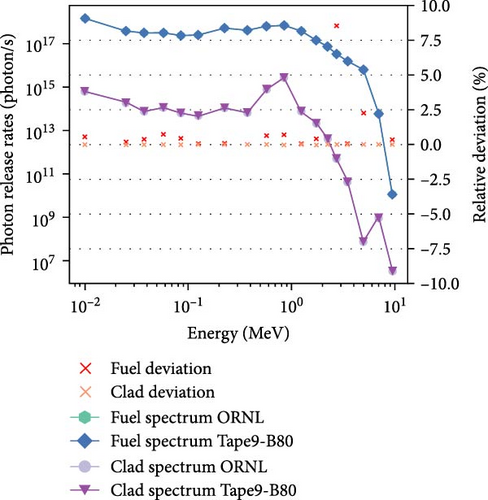

4.2. Impact on Activation Source Term Calculations
To assess the potential impact of the library on practical activation source term calculations, three types of materials commonly encountered in activation and source term calculations were selected: the decay of a single long-lived radionuclide, decay following irradiation of naturally abundant isotopes, and activation of mixed structural materials. The calculation of irradiation and decay processes for these materials was conducted, and the relative deviation in calculations between libraries was evaluated to assess the impact of data iteration on shielding source term analysis and reactor physics design.
Figure 5 presents the calculated radioactivity intensity during the decay processes of Am-242 m and Cf-252 radiation sources. By separately accounting for the total radioactivity intensity and the α-decay radioactivity intensity during the decay process, it was evident that the iteration of the new version of branching data caused a certain deviation in the calculation of the Am-242 m decay process, with almost all of this deviation coming from α-decay. The half-life of Am-242 m is ~141 years, and its main decay modes are isomeric transition (99.54%) and α-decay (0.46%), with the corresponding products being stable Am-242 and Np-238, respectively. Within 300 days, the main product in the system is Pu-238. In the nuclear library, the decay constant of Am-242 m was reduced by about 7.76%, the branching ratio of α-decay decreased by about 8.55%, and the branching ratio of isomeric transition increased by only 0.04%. Pu-238, with a half-life of 87.7 days, undergoes α-decay to form U-234 in a relatively short time, followed by long-term decay of U-234 and its α-decay product Th-230, with consistently small calculation deviations in this process. In contrast, the deviation in the decay process of Cf-252 is relatively small. The α-reaction that generates Cm-248 accounts for 99.99% of the decay process. Since there was no change in the α-decay branching ratio of Cf-252, the ~2% deviation in calculations is attributed to changes in the measured data for its half-life.
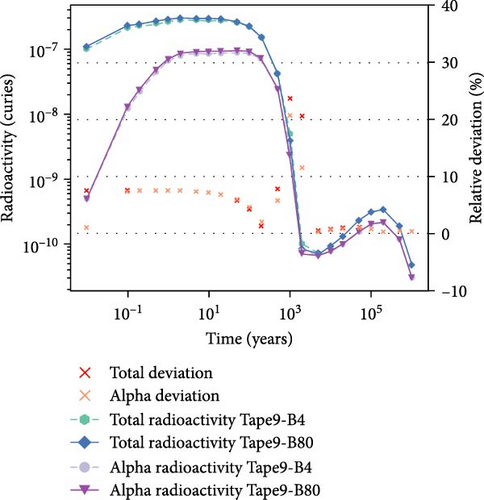
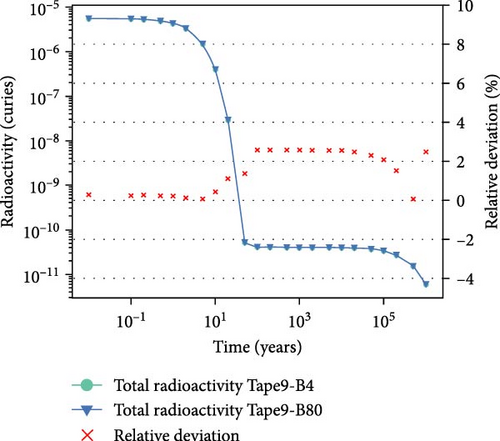
Figure 6 presents the discrepancies in photon emission rates calculated for 1 kg of naturally isotopic-abundant metal materials Fe, Pb, and W during a 1500-day constant flux irradiation followed by a 300-day decay period in a fast neutron reactor [16]. The analysis utilizes nuclear libraries 331, 332, and 333 for structural materials, As, and FPs, respectively. It is evident from the figure that there is a significant discrepancy in the calculated photon emission rate of metallic iron, particularly during the decay period immediately following irradiation, where the rate drops sharply, with relative discrepancies reaching ~30%. Such a level of discrepancy can impact the calculations for shielding. For metallic lead and tungsten, the discrepancies in photon emission rates during irradiation are relatively minor, with metallic lead showing less than 1% discrepancy and tungsten displaying a mere 0.8% deviation, which can be almost disregarded in actual shielding and activation calculations. The improved accuracy in photon emission rate calculations for metals like iron and lead during irradiation and decay processes is crucial for analyzing activation issues in advanced solid-state reactors.


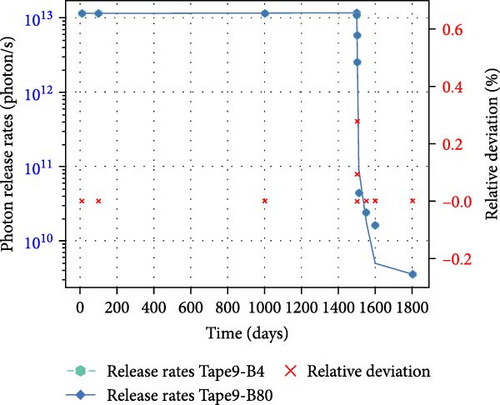
The design of advanced reactors increasingly relies on the use of composite materials, where the precision of activation calculations for mixed materials determines the reliability and accuracy of shielding designs.
Samples of antimony-beryllium core blocks, 304 stainless steel for reactor use, low-activation ferritic steel mixtures, and zirconium alloy materials were irradiated under low power conditions for 4380 days, followed by cycles of constant flux irradiation and zero flux decay until saturation. For these materials, isotopes from structural materials, As, and FPs categories utilized neutron cross-section databases 204, 205, and 206, respectively. The distribution of deviations in the radioactivity of selected source terms at each sampling point, as well as their differences based on normalized results, are illustrated in Figure 7a–d, highlighting the activity variation among different source terms. Notably, the irradiation results for the antimony-beryllium core blocks, an essential secondary neutron source component, displayed remarkably consistent deviations. The radioactivity deviation for the Fe-55 source term was around 1.5%, and for the Sb-125 source term, it was ~0.2%, primarily related to corrections in the decay data for antimony and its daughter nuclei, as inferred from the analysis of nuclide half-life deviations discussed earlier. The calculations for the 304 stainless steel and low-activation ferritic steel mixture in the Fe-55, N-59, and Ni-63 source terms showed deviations of about 2%, 5%, and 9%, respectively. Moreover, the steel mixture, having a more complex material composition, exhibited significant deviations in calculations for some low-yield radioactive and excited-state nuclides, such as Mo-93 and Te-125 m, with deviations around 15% and 2%, respectively. The zirconium alloy material demonstrated an overall unstable deviation in radioactivity calculations ranging from 1% to 4%, with larger deviations observed over long-term irradiation and lower deviations during short-term alternating decay periods. The calculation deviation for the Fe-55 source term exhibited a similar pattern.
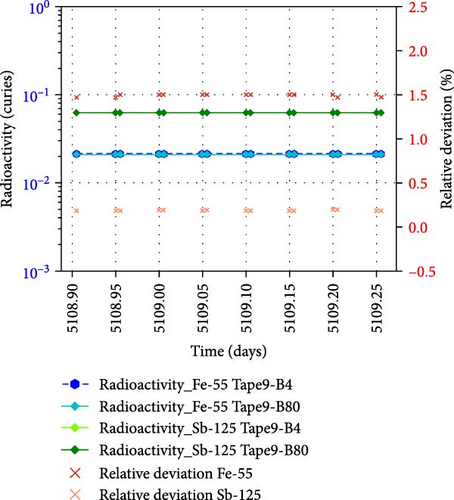
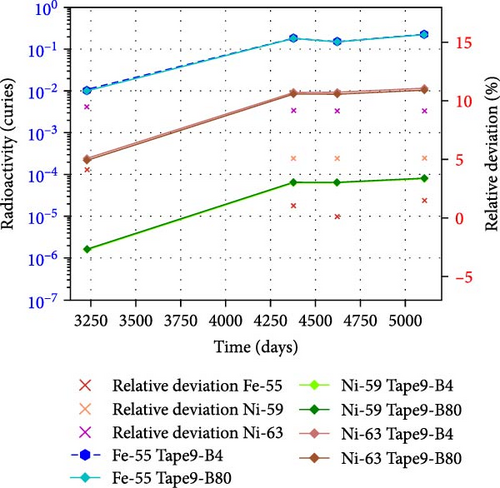
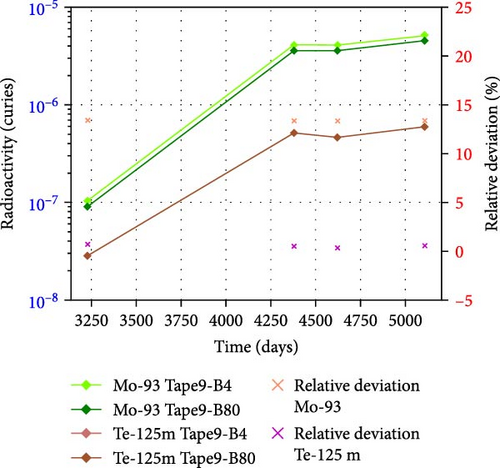
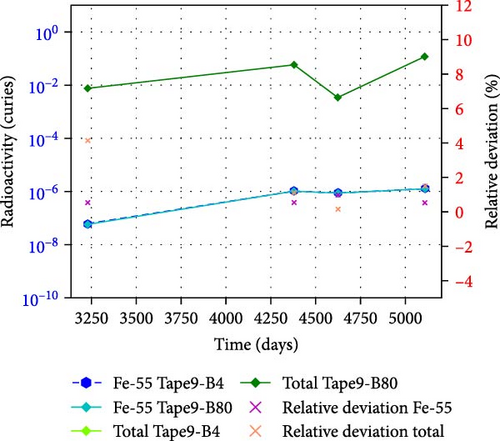
5. Conclusion
- 1.
The developed Tape9 library shows good agreement with benchmark values in irradiation and decay calculations of fuel and internal components for four different reactor types: PWRs, BWRs, CANDU reactors, and liquid metal-cooled fast reactors. The deviation in Kinf calculations for the reactor core does not exceed 30pcm. Photon and energy release rates are almost unbiased in the low-energy range and consistently remain within 10% in the high-energy range, demonstrating the validity of the library development methodology presented in this paper.
- 2.
The updated nuclear library Tape9-B80, based on ENDF/B-VIII.0, shows varying degrees of deviation in calculations for different materials compared to the original version of the library. Materials containing iron, nickel, and antimony isotopes generally exhibit larger calculation discrepancies.
- 3.
The iterative evaluation and update of nuclear data are of significant importance for enhancing the accuracy of irradiation and decay calculations in the ORIGEN2 program.
The methodology of this study can be applied to the development of source term libraries from other evaluated data sources. However, further validation is required to assess the lateral applicability and sensitivity of these libraries.
Conflicts of Interest
The authors declare no conflicts of interest.
Author Contributions
Xirui Zhang contributed to methodology, software development, formal analysis, validation, writing–original draft, and writing–review and editing. Dacai Zhang contributed to the numerical simulations, investigation, methodology, review, and editing. Wenxiang Fang and Te Sheng contributed to the analytic calculations and software development. Hao Luo and Ganglin Yu contributed to conceptualization, funding acquisition, and project administration.
Funding
This work was financially supported by the National Natural Science Foundation of China (No. 12375169).
Endnotes
Open Research
Data Availability Statement
The data that support the findings of this study are available from the corresponding author upon reasonable request.
- 1The term “command” refers to the pointer names assigned by the transmutation solver to different decay modes used to locate and call the corresponding decay data.




